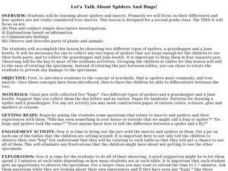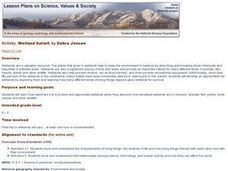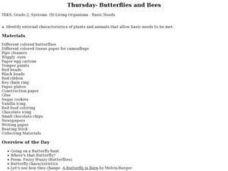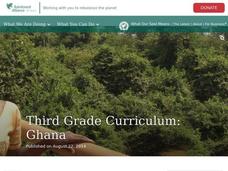Curated OER
Science: Bugs and Body Parts
Students determine the function of various insect parts they have observed. Using descriptive words, they explain the insects' characteristics and draw pictures of them. The instructional activity concludes with students writing short...
Curated OER
Habitat Breakdown
Fourth graders gain an understanding of how insects/organisms are impacted by factors that are essential to an organism's survival in a particular habitat. They see how lacking just one element of a habitat can affect an organisms chance...
Curated OER
Let's Talk About Spiders And Bugs!
Second graders study the differences between spiders and insects. They observe four different specimens in the classroom.
Curated OER
Carnivorous Plants: A Bugs Nightmare!
Students research carnivorous plants and how they trap insects. They role play as botanists to write a research field guide about a newly discovered imaginary carnivorous plant.
Curated OER
Wetland Safari!
Students identify how humans, fish, plants, birds, insects and other wildlife benefit from wetland environments. They observe a wetland and its inhabitants, draw a migration map that represents how birds use wetlands in traveling long...
Curated OER
Biology: Butterfly Activities
Second graders examine various types of butterflies and insects around their school. They identify differences between beetles and butterflies. Students examine books about butterflies, complete symmetry drawings, and make ladybug key...
Curated OER
Beetle Infestation
Seventh graders investigate the consequences of insect infestation of trees over a period of time. this lesson plan can tailgate a segment on the life cycle of beetles and lead off a environmental lesson plan.
Curated OER
Learning About Animals' Bodies
Students research different animals (mammals, reptiles, amphibians, insects, birds, fish) and create books, murals, dioramas, puppets, and sculptures to illustrate the necessity of various body parts for overall survival. In this animal...
Curated OER
From Caterpiller to Butterfly: Cycles, Circles, and Patterns
Students examine art of butterflies and discuss what they know about the insect. They create their own butterfly puppets and write a story to represent its life cycle.
Curated OER
Home Sweet Home-Far From Home
Students observe slides of U.S. coastal geography. They study topography and vegetation maps for one region. They gather geographic facts on a guided worksheet. Students pretend to be colonists. They decide what kind of economic system...
Curated OER
Flora and Fauna as Figures of Speech
Students view artwork in manuscript pages depicting insects, animals, plants, flowers, and ornate writing, such as those found in the Mira calligraphiae monumenta in the Getty Museum.
Curated OER
Guesstimate
Learners estimate large quantities. They first practice estimating beans in a tub. They solve a large scale problem using one method of estimating they learned while watching the video, "Eddie Files".
Curated OER
Charlotte's Web
Young scholars compare the differences in insects and spiders and design a worksheet that teaches the differences. Students record on chart
organizing the information about the pet, its food, habitat, exercise, and other ways to care...
T. Smith Publishing
Counting to Five
Rows of cartoon-style animals are displayed for your mini mathematicians to count. At the end of each row, they write the number of animals counted. Numbers only range from 1 to 5, so this is most appropriate for absolute beginners. Cute!
Curated OER
How Does the Rice Farmer Help Birds When They Fly South in the Winter Time?
Students draw a picture of a bird in a rice field. In this social studies lesson, students then fold a piece of paper so that there are 4 spaces. Students then draw one thing in each square that birds get from the rice field.
Curated OER
How Do We Forecast Weather?
Third graders investigate how scientists collect weather data in order to forecast the weather. They work in small groups in order to research one type of weather technology such as, satellite images, radar, surface observations, or...
Curated OER
Rainforest Complexity and Diversity
Second graders investigate the diversity of plants and animals in a rainforest. They watch an online story developed by the Rainforest Alliance, observe and record animals in their local area, explore various websites, and compare and...
EngageNY
Conducting Research: Asking and Answering our Questions about Rainforest Arthropods
Let's ask an expert. Scholars divide into groups to research and become experts on either ants or butterflies. Learners use task cards and text on their topic to complete a note catcher. At the end, they share their information with a...
EngageNY
Revision and Illustration: Strengthening the Writing in my Rainforest Field Journal and Adding a Labeled Drawing
Let me draw you a picture. Scholars read a quote from Roger Tory Peterson and discuss his views on drawings. They then create their own drawings of an ant or butterfly to add to their science journals.
Curated OER
Surviving in Our Ecosystems
Third graders investigate the balance of ecosystems and how each species has different survival needs. They research on the internet using the site included. They then participate in activities/centers utilizing the facts they discovered.
Curated OER
Pollination Power
Second graders study and examine the structure of a flower. In this pollination lesson, 2nd graders observe pollinators in the garden and dissect a flower. Students then plant strawberry plants in the garden and observe the process of...
Curated OER
Food Chain
Fourth graders explore the concept of food chains. In this food chain lesson, 4th graders discuss what different animals eat and how they are all connected. Students explore a garden and the environment around them to find examples of a...
Curated OER
Cricket Wars
Third graders explore living and nonliving things in a garden environment. In this garden environment instructional activity, 3rd graders study the effects of crickets in a garden. Students explore the interaction between living and...
Curated OER
Presto Change-o: Caterpillars to Butterflies
Students use the Internet to explore the four stages of a butterfly's life cycle. They make a model of a butterfly using macaroni, sticks and leaves.

























